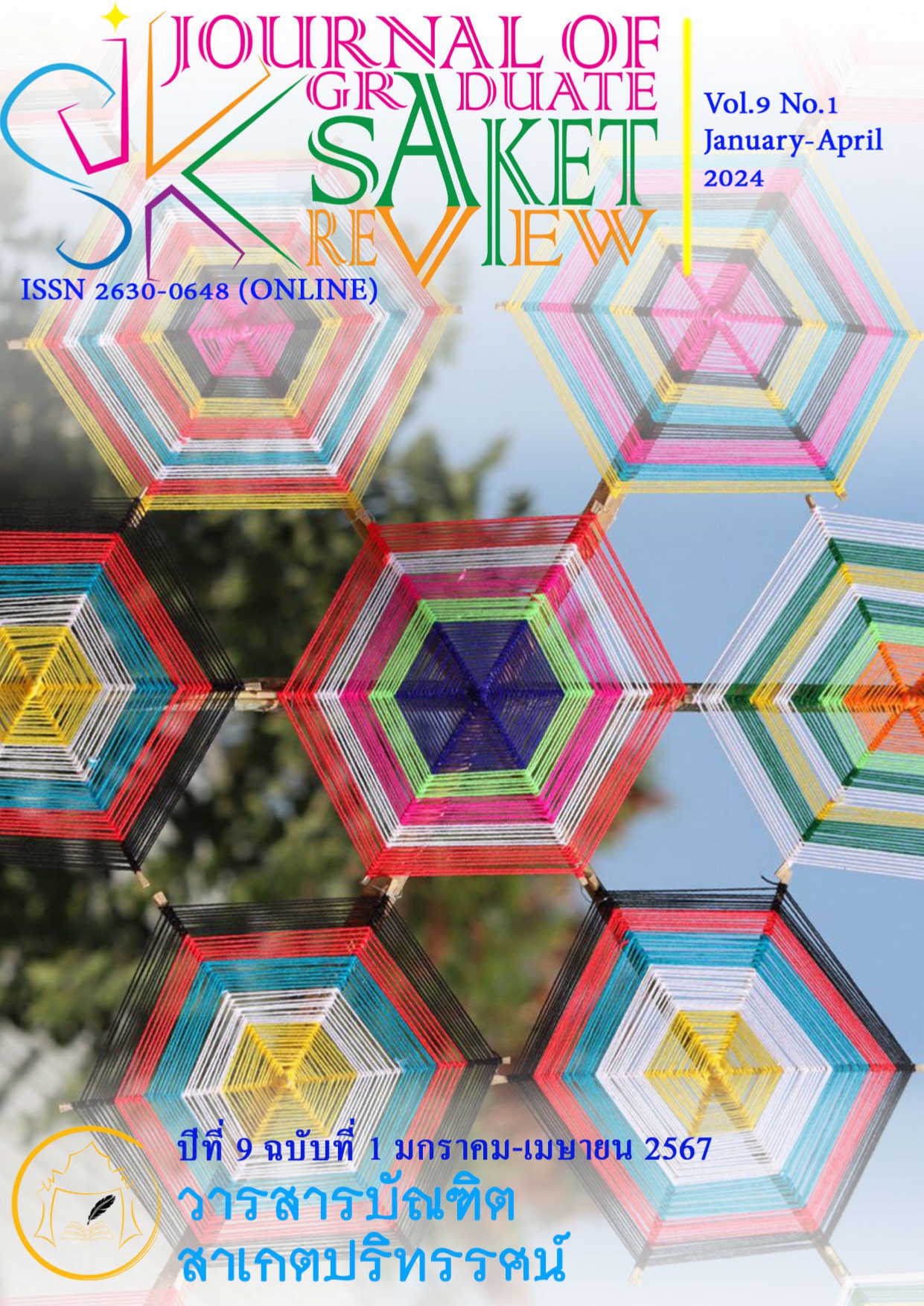Water pouring: correct beliefs and practices
Main Article Content
Abstract
This academic article aims to study beliefs and practices regarding correct water pouring. The results of the study found that The pouring of water or the pouring of Dakshinodaka first occurred in Buddhism during the period of King Bimbisara dedicating merit to his relatives. However, it is assumed that it was modeled after Brahmanism, which was done in those days offering Dakshinodaka water has three purposes: 1) offering it to wash the hands of the Lord Buddha or me; 2) as a confirmation of donation or offering something 3) to dedicate merit to petchana, there are 4 methods of pouring water: 1) The method of pouring water by King Bimbisara 2) Pouring out Udhisodaka or pouring Udhisodaka It is the granting of specific ownership rights. 3) The secretion of pattanotok. Giving by pouring water in the form of making a wish. 4) The pouring of water in the Sakkhinodaka style is the type that is currently being done, the pouring of water today is connected to the event of Mother Earth squeezing the bun of the hair to make the water (Thaksinotok) flow. The shoulders of Mara and the Devil were defeated when he faced the Buddha after his new enlightenment. The practice of pouring water today is different from that of the Buddha's time. That is, pouring water onto the container. It is not offering dakshinodaka or pouring water on the hands of the recipient. One specific form of pouring water is pouring water or pouring water to break ties with Hongsawadee and proclaim the independence of Ayutthaya by King Naresuan the Great. The incorrect form of pouring water is to use the hands and arms of the person pouring water. The pouring of water in the Imina and Yangkinji is a way of dedicating merit to gods, humans, animals, and oneself, as well as making a wish for rain to fall according to the season, which is both similar and different from general water pouring at present.
Article Details

This work is licensed under a Creative Commons Attribution-NonCommercial-NoDerivatives 4.0 International License.
เนื้อหาและข้อมูลในบทความที่ลงตีพิมพ์ในวารสารบัณฑิตสาเกตปริทรรศน์ ถือเป็นข้อคิดเห็นและความรับผิดชอบของผู้เขียนบทความโดยตรงซึ่งกองบรรณาธิการวารสาร ไม่จำเป็นต้องเห็นด้วย หรือร่วมรับผิดชอบใด ๆบทความ ข้อมูล เนื้อหา รูปภาพ ฯลฯ ที่ได้รับการตีพิมพ์ในวารสารบัณฑิตสาเกตปริทรรศน์ ถือเป็นลิขสิทธิ์ของวารสารบัณฑิตสาเกตปริทรรศน์ หากบุคคลหรือหน่วยงานใดต้องการนำทั้งหมดหรือส่วนหนึ่งส่วนใดไปเผยแพร่ต่อหรือเพื่อกระทำการใด ๆ จะต้องได้รับอนุญาตเป็นลายลักอักษรจากวารสารบัณฑิตสาเกตปริทรรศน์ ก่อนเท่านั้น
References
ภาษาไทย
ธรรมสภาและสถาบันบรรลือธรรม. (2554). ปฐมสมโพธิกถา. กรุงเทพมหานคร: สำนักพิมพ์ธรรมสภา.
นายอินทร์ เอียด. (2558). การศึกษาวิเคราะห์เรื่องการอุทิศส่วนบุญในประเพณีสารทเขมร (พฺจุมเบ็ญ). ศิลปศาสตรมหาบัณฑิต สาขาวิชาพุทธศาสนศึกษา ภาควิชา
ปรัชญา คณะศิลปศาสตร์ มหาวิทยาลัยธรรมศาสตร์.
พระครูอรุณธรรมรังสี. (ม.ป.ป.). มนต์พิธี. กรุงเทพมหานคร: ม.ป.ท..
พระศรีวิสุทธิญาณ. (2505). ประเพณีกรวดน้ำ. กรุงเทพมหานคร: ม.ป.ท..
พันจันทนุมาศ (เจิม) และจักรพรรดิพงศ์ (จาด). (2507). พระราชพงศาวดารกรุงศรีอยุธยา. พระนคร: คลังวิทยา.
มหามกุฏราชวิทยาลัย. (2556). พระไตรปิฎกสยามรัฐ ภาษาบาลี. พิมพ์ครั้งที่ 7. กรุงเทพมหานคร: มหามกุฏราชวิทยาลัย.
________. (2556). พระไตรปิฎกและอรรถกถาแปล ฉบับมหามกุฏราชวิทยาลัย. พิมพ์ครั้งที่ 8. กรุงเทพมหานคร: มหามกุฏราชวิทยาลัย.
สมเด็จพระพุทธโฆษาจารย์. (2566). พจนานุกรมพุทธศาสน์ ฉบับประมวลศัพท์. พิมพ์ครั้งที่ 62. นครปฐม: วัดญาณเวศกวัน.
สมเด็จพระสังฆราช (ปุสฺสเทว). (2453). สวดมนต์ฉบับหลวง. พระนคร: โรงพิมพ์ ไทย สะพาน ยศเส.
ภาษาอังกฤษ
Dhamma Council and Banluetham Institute. (2011). Pathamasambodhikatha. Bangkok: Thammasabha Publishing House.
Eath I.. (2015). “an analytical study of the doctrine of merit transference in the khmer's pchum ben ceremony”. Master of Arts.
Department of Buddhist Studies Department of Philosophy Faculty of Liberal Arts Thammasat University.
Phrakru Arun Thamrangsi. (M.P.T.). Ceremonial mantra. Bangkok: M.P.T..
Phra Sri Wisutthiyan. (1962). The tradition of pouring water. Bangkok: M.P.T.
Panchanthanumat (Cherm) and Chakraphatphong (Jad). (1964). The Royal Chronicles of Ayutthaya. Phra Nakhon: Khlangwittaya.
Mahamakut Buddhist University. (2013). Tripitaka Siamrath, Pali language. 7th printing. Bangkok: Mahamakut Buddhist University.
________. (2013). Tripitaka and translated Commentary. Mahamakut Buddhist University edition. 8th printing. Bangkok: Mahamakut
Buddhist University.
Somdej Phra Buddhakosajarn. (2023). Dictionary of Buddhism. Glossary edition. 62nd printing. Nakhon Pathom: Wat Yanwetkhawan.
Somdej Phra Sangharaja (Pussadeva). (1910). Royal version of prayers. Phra Nakhon: Thai Printing House, Saphan Yotse.

